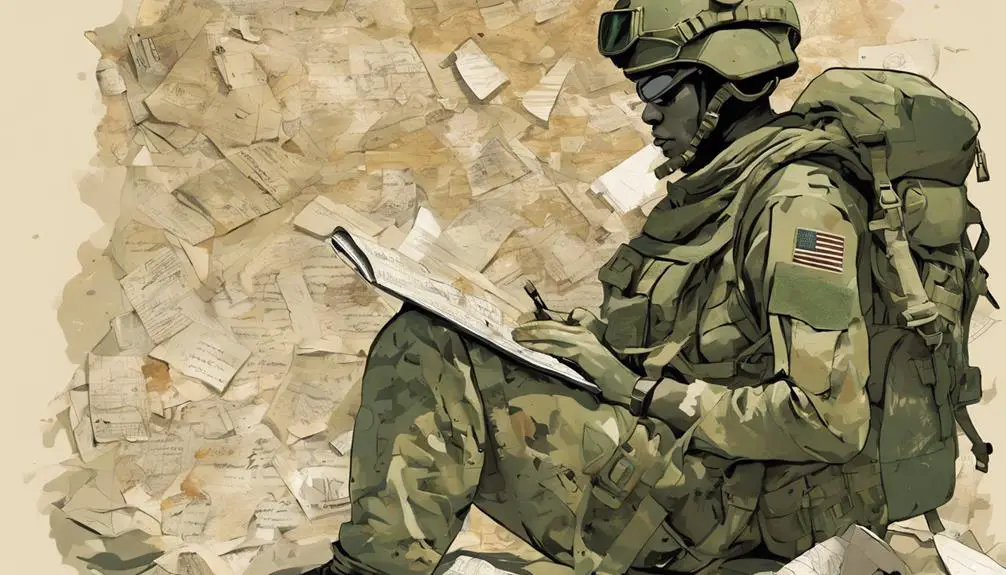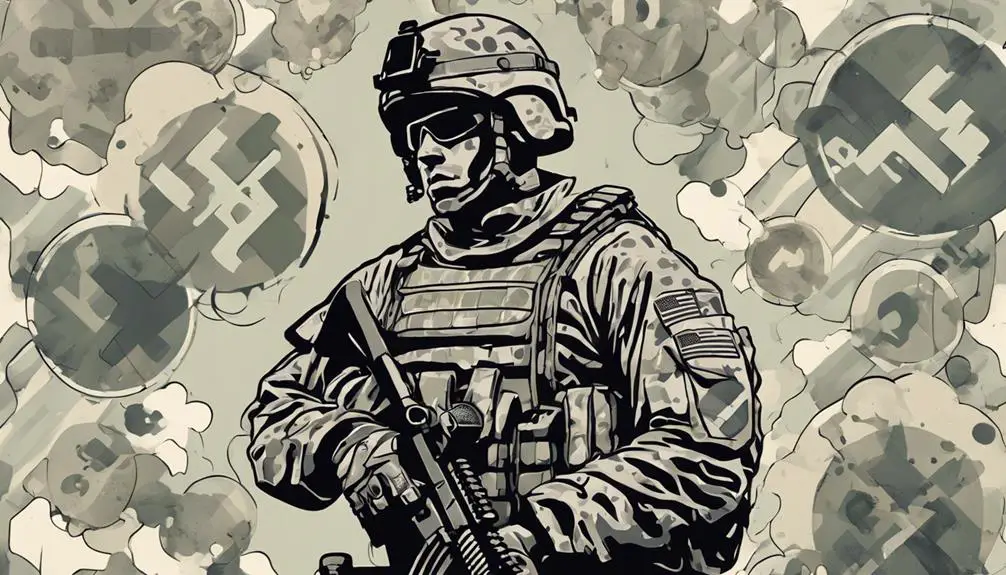You'll frequently encounter acronyms and slang in US military communication, which have become an integral part of the military culture, serving as a unique linguistic system that enables efficient and accurate exchange of critical information in high-pressure environments. Born out of necessity, military slang emerged to provide clarity and brevity in life-or-death situations. Today, acronyms like SITREP, ROE, and CAS are essential in battle, conveying complex info swiftly. As you explore the world of military slang, you'll uncover a rich history, cultural nuances, and humor that'll give you a deeper understanding of this specialized language.
Origins of Military Acronym Slang

As you explore the world of military communication, it becomes evident that the extensive use of acronym slang originated from the need for brevity and clarity in high-stress, fast-paced environments. This historical significance is rooted in the early days of military communication, where speed and accuracy were essential in transmitting important information. The use of acronyms allowed for quick and efficient communication, reducing the risk of miscommunication and errors.
Cultural influences also played a significant role in shaping the military's reliance on acronym slang. The military's diverse cultural landscape, comprising individuals from various backgrounds, necessitated a common language that could be understood by all. Acronyms became a universal language, transcending cultural and linguistic barriers.
As a result, acronym slang became an integral part of military communication, allowing personnel to quickly convey complex information in high-pressure situations. By understanding the origins of military acronym slang, you'll gain insight into the historical significance and cultural influences that have shaped the way the military communicates.
Declassifying Military Jargon
You'll find that understanding military jargon requires more than just familiarity with acronyms, as the nuances of military communication extend far beyond abbreviated phrases.
To truly grasp military jargon, you need to take into account the cultural context in which it's used. Cultural barriers can often hinder effective communication, making it essential to address language accessibility in military communication.
Barrier: Language
Impact: Hindered communication
Solution: Multilingual training
Barrier: Cultural
Impact: Misunderstanding
Solution: Cultural awareness training
Barrier: Technical
Impact: Limited accessibility
Solution: Simplified technical language
Barrier: Environmental
Impact: Noise and distractions
Solution: Adapted communication strategies
Acronyms in the Field

In the heat of battle, acronyms serve as an essential shorthand, allowing you to swiftly convey critical information to your comrades. In combat zones, every second counts, and using acronyms helps to reduce communication time, ensuring that you can respond quickly to changing situations.
When communicating via radio protocols, acronyms are especially vital. They enable you to convey complex information efficiently, without sacrificing clarity.
For instance:
- SITREP: Situation Report, providing an update on the current battlefield situation.
- ROE: Rules of Engagement, outlining the circumstances under which you can engage the enemy.
- CAS: Close Air Support, requesting air support to neutralize enemy positions.
- EOD: Explosive Ordnance Disposal, calling in experts to defuse explosive devices.
Slang for Humor and Relief
When you're not relying on acronyms to convey critical information, military slang often serves as a release valve, allowing you to blow off steam and find humor in the tensest of situations. In the high-stress environment of the military, slang becomes a Moral Booster, helping to lift spirits and provide comic relief. It's a way to poke fun at the absurdity of certain situations, making them more bearable.
| Slang Term | Meaning | Purpose |
|---|---|---|
| FOB (Forward Operating Base) | A remote military outpost | Stress Reliever, emphasizing the remoteness of the location |
| COS (Combat Operation Sense) | Common sense in high-stress situations | Moral Booster, highlighting the importance of staying calm |
| SITREP ( Situation Report) | A report on the current situation | Stress Reliever, providing a humorous take on a serious report |
| OBE (Overcome By Events) | When a situation becomes irrelevant due to changing circumstances | Moral Booster, poking fun at the unpredictability of war |
| ROE (Rules of Engagement) | Guidelines for military operations | Stress Reliever, highlighting the complexity of military protocols |
Evolution of Military Lingo

As military operations evolve, so does the language, with new slang terms emerging to describe novel technologies, tactics, and situations, while others fall out of use, reflecting the dynamic nature of military lingo.
You, as a part of the military, are witness to this evolution, where language adapts to the changing needs of the armed forces. This evolution has significant cultural and historical implications, as it reflects the values, attitudes, and experiences of the military community.
The evolution of military lingo has:
- Influenced popular culture, with military slang terms being adopted into civilian language.
- Reflected historical events, with slang terms emerging in response to specific conflicts or operations.
- Shaped military identity, with slang terms conveying a sense of belonging and shared experience.
- Preserved historical significance, with slang terms serving as a record of military history and tradition.
Behind the Abbreviations
You're likely familiar with the proliferation of acronyms in military communication, where brevity and clarity are paramount. Behind the abbreviations, however, lies a rich etymology that's often overlooked. Delving into the history of military nomenclature reveals a fascinating narrative of adaptation and innovation.
Acronym etymology, in particular, provides valuable insights into the evolution of military language. Many acronyms have origins rooted in World War II, when the need for concise communication became essential. Terms like 'SNAFU' ( Situation Normal: All Fouled Up) and 'FUBAR' (Fouled Up Beyond All Recognition) emerged as humorous ways to describe chaotic situations. These early acronyms laid the groundwork for modern military nomenclature, where clarity and precision are vital.
As you explore the world of military acronyms, you'll discover a complex tapestry of abbreviations, each with its unique history and significance. By examining the etymology behind these abbreviations, you'll gain a deeper appreciation for the intricate language of the US military.
Frequently Asked Questions
Are Military Acronyms Only Used in the US Military?
As you explore the world of acronyms, you might wonder if they're exclusive to the US military. The answer is no. Military forces globally use acronyms to simplify complex terminology.
In addition, NATO's global reach relies heavily on standardized acronyms, facilitating communication among member nations.
Additionally, acronyms have cultural significance, transcending military contexts to permeate everyday language, making them a ubiquitous aspect of modern communication.
Can Civilians Use Military Acronyms in Informal Conversations?
When you incorporate military acronyms into casual conversations, you're walking a fine line between cultural appropriation and linguistic evolution.
While it's not uncommon for civilians to adopt military jargon, it's crucial to take into account the social norms and context.
Using acronyms in a conversational tone can come across as authentic or even cool, but be mindful of your audience and avoid appearing pretentious.
Are All Military Acronyms Officially Approved by the Pentagon?
As you explore the world of military acronyms, you wonder if they're all officially approved by the Pentagon. The answer is no, not all acronyms are formally sanctioned.
While some are vetted through a rigorous approval process, others are created on the fly by troops in the field. Pentagon oversight is important, but it's not always a requirement.
The approval process can be lengthy, and sometimes, acronyms become widely used before formal recognition.
Do Other Countries' Militaries Use Similar Acronym Slang?
As you explore military communication styles globally, you'll find that many countries' militaries use acronym slang similar to the US. International comparisons reveal that the use of acronyms is a common thread across militaries.
In fact, a cross-cultural analysis of military communication patterns shows that acronym slang is a widespread phenomenon, employed to enhance efficiency and clarity in high-stress environments.
You'll discover that militaries worldwide adopt acronyms to facilitate quick understanding and effective decision-making.
Are Military Acronyms Used in Formal Military Communications?
As you explore the world of military communications, you'll find that acronyms play a vital role.
When it comes to formal reports and secure transmissions, you'll rarely spot acronyms. Instead, military personnel opt for clear, concise language to guarantee precision and avoid misinterpretation.
In formal military communications, brevity is key, but clarity takes precedence over convenience. You won't find acronyms replacing crucial information, as accuracy is paramount in high-stakes situations.
Conclusion
As you wrap up your journey through the world of military acronym slang, remember that it's not just an essential tool for efficient communication – it's a crucial tool.
Consider this: the US military uses over 15,000 acronyms, with new ones emerging every year. That's equivalent to a 400-page dictionary!
The next time you hear a vet say 'FOB' or 'SITREP,' you'll know they're not just speaking gibberish – they're speaking a language born out of necessity and camaraderie.







